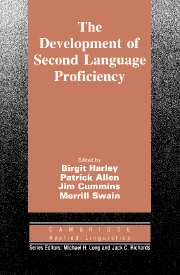Book contents
- Frontmatter
- Contents
- List of contributors
- Series editors' preface
- Acknowledgments
- Introduction
- I THE NATURE OF LANGUAGE PROFICIENCY
- II CLASSROOM TREATMENT
- III SOCIAL AND INDIVIDUAL VARIABLES
- Chapter 9 Social and individual factors in the development of bilingual proficiency
- Chapter 10 Social and individual factors in language acquisition: some models of bilingual proficiency
- Chapter 11 The role of context and age in the development of bilingual proficiency
- Chapter 12 The relationship between first and second languages: language proficiency and language aptitude
- Chapter 13 Response by DBP project members to the discussion papers of Richard Bourhis and Alison d'Anglejan
- IV PRACTICAL AND POLICY IMPLICATIONS
- V THIRTY-FIVE YEARS OF RESEARCH ON BILINGUALISM
- CONCLUSION
- References
- Author Index
- Subject Index
Chapter 10 - Social and individual factors in language acquisition: some models of bilingual proficiency
Published online by Cambridge University Press: 05 October 2012
- Frontmatter
- Contents
- List of contributors
- Series editors' preface
- Acknowledgments
- Introduction
- I THE NATURE OF LANGUAGE PROFICIENCY
- II CLASSROOM TREATMENT
- III SOCIAL AND INDIVIDUAL VARIABLES
- Chapter 9 Social and individual factors in the development of bilingual proficiency
- Chapter 10 Social and individual factors in language acquisition: some models of bilingual proficiency
- Chapter 11 The role of context and age in the development of bilingual proficiency
- Chapter 12 The relationship between first and second languages: language proficiency and language aptitude
- Chapter 13 Response by DBP project members to the discussion papers of Richard Bourhis and Alison d'Anglejan
- IV PRACTICAL AND POLICY IMPLICATIONS
- V THIRTY-FIVE YEARS OF RESEARCH ON BILINGUALISM
- CONCLUSION
- References
- Author Index
- Subject Index
Summary
My comments are focused on the social and individual variables aspect of the Development of Bilingual Proficiency project, specifically the research presented in the final DBP report entitled “The language use patterns, language attitudes, and bilingual proficiency of Portuguese- Canadian children in Toronto” (Cummins, Lopes, and King 1987).
Overview of the Portuguese-Canadian study
The Cummins et al. (1987) study is particularly interesting, since unlike other second language learning studies conducted in Canada (Gardner 1985), it focused on the bilingual proficiency of nonofficial language group speakers, in this case Portuguese-Canadian pupils. As pointed out by Cummins et al. (1987), Portuguese-Canadians are members of a low status group whose job mobility is relatively limited and whose socioeconomic standing remains working class within the social structure.
While research by Reitz (1980) has shown that Portuguese-Canadians have experienced job segregation since their arrival in Canada, research by Balakrishnan and Kralt (1987) has also shown that Portuguese- Canadians are highly concentrated residentially within cities such as Toronto, Montreal, and Vancouver. Indeed, Balakrishnan and Kralt (1987) have found that recent immigrant groups such as Portuguese- Canadians are more segregated residentially than black-Caribbean and Indo-Pakistani minority groups in major cities across Canada. Prejudice and discrimination against newly arrived immigrant groups (Berry, Kalin, and Taylor 1977) are not the only reason for the high rate of residential segregation found among Portuguese-Canadians. Balakrishnan and Kralt (1987) suggest that lack of fluency in English among firstgeneration Portuguese-Canadians helps to account for the residential segregation as well.
- Type
- Chapter
- Information
- The Development of Second Language Proficiency , pp. 134 - 145Publisher: Cambridge University PressPrint publication year: 1990
- 1
- Cited by



